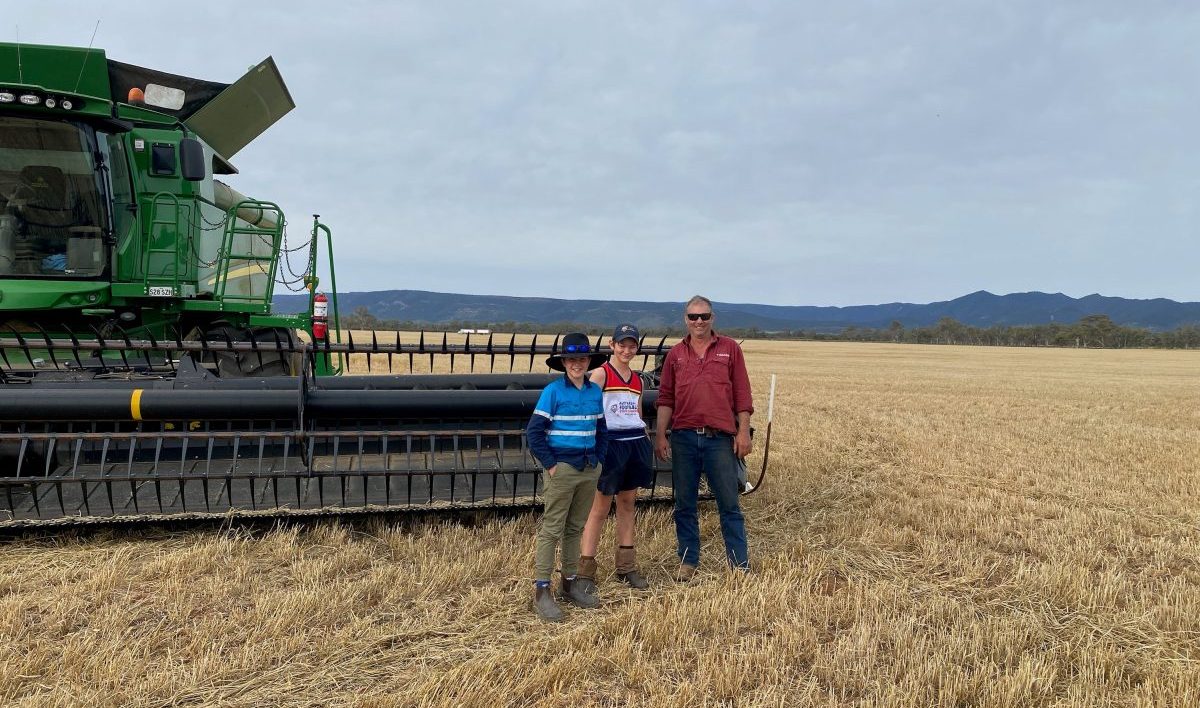
Sam Bussenschutt with son Sam (centre) and nephew Fletch in the family’s paddock of barley which provided the first load into Viterra’s South Australian network for this harvest. Photo: Viterra
PROMPT prices for feed wheat, barley and sorghum have rallied in the past week as rain and localised flooding limit access to stored grain in New South Wales.
Harvest is now under way in Queensland, Western Australia and South Australia, but showery and mild weather this week is certain to make an already late crop mature even later.
Recent rain, with more forecast, has forced some shorts into the market to look for whatever grain can be outturned at short notice.
While southern new-crop barley and SFW prices are under forecast supply-side pressure, the northern market has firmed across the board.
Global factors, especially the weak Australian dollar, are supporting values for new-crop feedgrain.
| Prompt | Oct 6 | Jan-Feb | Oct 6 | |
| Barley Downs | $395 | $378 | $385 | $375 |
| SFW wheat Downs | $415 | $400 | $400 | $395 |
| Sorghum Downs | $392 | $370 | $385 | $345 |
| Barley Melbourne | $395 | $368 | $360 | $368 |
| ASW Melbourne | $460 | $420 | $440 | $440 |
| SFW Melbourne | $420 | $400 | $390 | $400 |
Table 1: Indicative prices in Australian dollars per tonne.
Delayed harvest lifts north
In the week to 9am today, patchy rain in NSW brought big registrations to locations in already sodden parts of the state.
Totals include: Dubbo 91mm; Grenfell 30mm; Gunnedah 55mm; Narrabri 44mm, and Parkes 38mm.
Wheat crops in NSW and southern Queensland are late enough to still be filling.
In Queensland, most cropping areas had a dry week, but some districts had significant rain.
They included: Clermont 57mm; Macalister 20mm; Miles 24mm; Roma 18mm, and Springsure 13mm.
Goondiwindi-based broker Gerard Doherty, Knight Commodities, said while Central Queensland (CQ) was often close to finishing its winter-crop harvest by mid-October, it could be as little as 20 per cent through.
“It’s very stop start up there; it’s been cloudy and showery,” Mr Doherty said.
While some CQ growers have dodged the rain and finished harvest, others are off to a slow start, and unusually low protein is prevalent.
“It’d be at least 50pc ASW coming in, with APW, H2 and APH2, and yields are good at 3.5-5 tonnes per hectare.”
Prices are also strong as exporters look to accumulate new-crop where they can.
“Growers are getting more than $400/t depot.”
In the NSW-Queensland border region, Mr Doherty said the barley harvest could be under way by next week, weather permitting.
“A few guys are having a nibble on the barley; moisture’s up there, but we might see some barley come off over the next couple of days.”
Mr Doherty said consumers including feedlots were in the market.
“There are some prompt opportunities for anyone with SFW or F1; if it’s accessible and the market can get it in the next week or two, they’ll take it.”
While stocks of grain are held on farm and by handlers in the northern market, Mr Doherty said access was behind this week’s rally.
On the plus side, growers are making good progress on planting sorghum at the ideal time.
“We might be 50pc planted now, and pushing 60pc in this region.”
Wet feet in south
Shorts are also appearing in the southern market as flood warnings continue to be issued for most of the state’s inland rivers.
“The market’s out and about based on shorts and the wet weather,” Peters Commodities Riverina-based trader Peter Gerhardy said.
“There are that many roads closed to trucks that you haven’t got access to all the places you want to get into,
“It’s logistics that are causing the headaches.”
Crops on the slopes of NSW, and in all parts of Victoria and South Australia, have above-average yield potential.
However, much of the NSW plains country is waterlogged, and even crops in good health may be hard to get to with the header once they ripen because they are sitting in saturated ground.
“I’m saying harvest down here might start in the second week of November and finish at the end of February.”
This contrasts with normal years, when growers can expect to finish harvest by Christmas.
Mr Gerhardy said domestic consumers were chasing ASW rather than SFW wheat, even though old-crop SFW is in abundance in NSW.
Protein wheat from any part of Australia is looking extremely unlikely in volume, and Mr Gerhardy said protein spreads continue to widen.
“New-crop APW delivered Melbourne is $465; that tells you something.”
Grain Central: Get our free news straight to your inbox – Click here

HAVE YOUR SAY